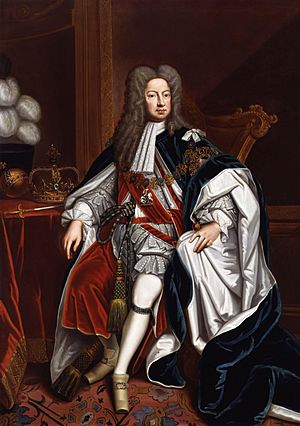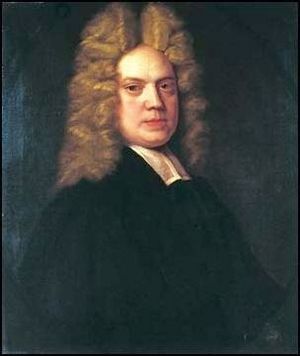Coronation riots facts for kids

The coronation riots of October 1714 were a series of protests in southern and western England. People were upset about the crowning of George I, who was the first king from the Hanoverian family to rule Great Britain. These riots showed how much some people disagreed with the new king and his government.
Contents
Why the Riots Happened
When Queen Anne, the last ruler from the Stuart family, passed away in August 1714, George Louis, the Elector of Hanover, became the new king. This happened because of a law called the Act of Settlement 1701. This law said that Anne's half-brother, James Francis Edward Stuart, could not become king.
After George I arrived in Britain in September, he quickly changed the government. He removed the Tories from power. Instead, he chose a government mostly made up of Whigs. This change made many people, especially Tories and their supporters, very unhappy.
What Happened During the Riots
On October 20, King George I was crowned at Westminster Abbey. People who supported the new king celebrated with parties and bonfires. But in more than twenty towns across southern and western England, these celebrations were interrupted by angry crowds.
These rioters were often supporters of what was called "High Church" ideas. They also supported a famous preacher named Henry Sacheverell. Many important Tory leaders and wealthy people did not attend the coronation. In some towns, they even joined their supporters to cause trouble during the celebrations.

The rioters attacked the coronation parties. They damaged properties and sometimes hurt people who were celebrating. Many rioters mentioned Henry Sacheverell, who was traveling in the West Country at the time.
- In Taunton, they shouted, "Church and Dr. Sacheverell!"
- In Birmingham, they yelled, "Kill the old Rogue [King George], Kill them all, Sacheverell for ever!"
- In Tewkesbury, they cried, "Sacheverell for ever, Down with the Roundheads!"
- In Shrewsbury, the cry was, "High Church and Sacheverell for ever!"
The rioters also showed their "High Church" beliefs by attacking Dissenters. Dissenters were Protestants who were not part of the official Church of England. In Bristol, a Dissenting meeting place was damaged. In Dorchester, another Dissenting meeting-house was attacked. Rioters also showed support for local Tory leaders. For example, in Canterbury, they shouted for "Hardress and Lee".
Along with their anger at King George, some rioters also showed support for Jacobitism. This meant they secretly supported James Stuart, the half-brother of Queen Anne, who was also known as "the Pretender." Supporting him was against the law.
- In Taunton, one person said he would "take up Arms against the King."
- In Birmingham, a rioter said they should "pull down this King and Sett up a King of our own."
- In Dorchester, rioters tried to save a dummy of James Stuart that Dissenters planned to burn. They asked, "Who dares disowne the Pretender?"
- In Tewkesbury, some people wanted to toast Sacheverell and the King. When asked which king, James or George, they shouted, "Sacheverell for ever, Down with the Roundheads!"
In Bedford, a maypole was decorated as if it were in mourning. The maypole was a symbol of the Stuart monarchy. It was also linked to May day and Restoration Day, which celebrated the return of the monarchy in 1660 after the Puritans had banned maypoles. People used this to suggest that the new Hanoverian rule was like the Puritan rule.
Most Anglican clergy, who were church leaders, stayed out of the riots. However, in Newton Abbot, the minister removed the bell-clappers. This stopped the church bells from ringing to celebrate the coronation.
What Happened After the Riots
The government did not trust local courts to deal with the rioters. They tried to bring the accused rioters to London for trial, but this plan did not work well. Five rioters from Taunton were brought to London but were later let go on bail. Seven rioters from Bristol were supposed to be tried by a special group of judges. However, this only made the riots worse. There was even an attack on the Duke of Richmond in Chichester.
Rioters shouted at the judges, "No Jeffrey, no Western Assizes!" and later, "A Cheverel, A Cheverel, and down with the Roundheads...up with the Cavaliers!" Some rioters were whipped, fined, or put in prison for three months.
The general election of 1715 also had some riots. After the election, the Whig party gained more power in the House of Commons. To stop future disturbances like these, the new Whig government passed a law called the Riot Act. This law made it easier for authorities to control large, unruly crowds.
See also

